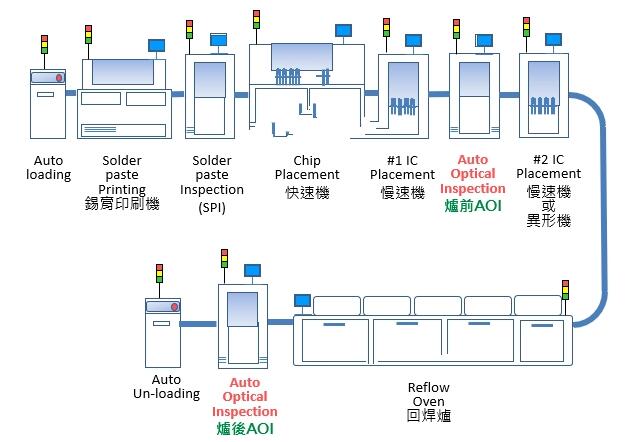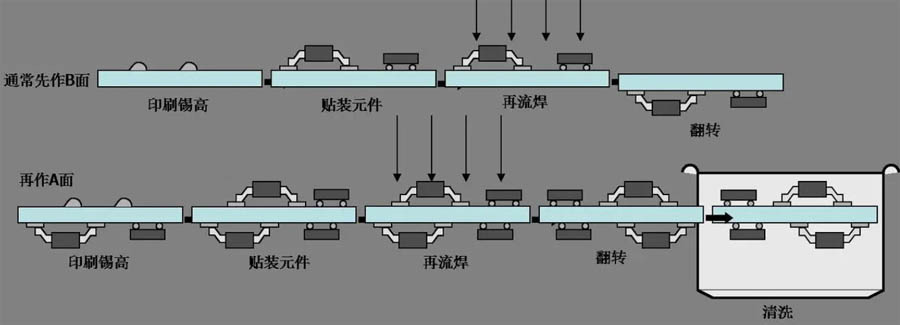There is no actual SMT factory to stay in the SMT process of the basic process and the important process is not necessarily understand, today I will tell you about the SMT process in the three main processes.
SMT process is now the most popular electronic assembly industry in a technology and process. This process is very complex, different products process is different, the basic process is as follows: incoming inspection -> burn-in -> printing -> inspection -> mounting -> furnace inspection -> reflow soldering -> AOI inspection -> rework -> test -> assembly.
In the SMT process processing process, no matter how many processes or procedures are less than the three main processes of SMT: solder paste printing -> SMT process -> reflow (soldering)

Solder Paste Printing
Solder Paste Printing is to print solder paste on PCB substrate.The equipment and tools used for printing are:
Printing machine:Fully automatic printing machine and semi-automatic printing machine.
Solder Paste:Solder Paste is a kind of material which is used to fix the material and the PCB board with a kind of special material.
Stencil: Simply put, it is a mould that skeletonises the PCB with pads to allow solder paste to penetrate the pads from these skeletonised positions. It is a very thin sheet of steel, with a mesh frame to fix the sheet, very flat, the most commonly used thickness of 0.10mm, according to the different components of different products and choose a different thickness of the sheet, and the production process. This is based on the R & D or customer-provided Gerber files have a paste mask file to produce, this work is required to be completed before production, because the stencil production has another production process and production process, the quality of the stencil determines the product quality of the patch, so it is very important. The more precise components can reflect the importance of the stencil, and different printers have slightly different requirements for the stencil hole, according to personal experience, if the product has a 0.4pitchBGA and other similar precision devices, it is recommended that the customer does not provide stencils, can be made by the professionals in the production plant, because the process is not a strict standard, the specific details, SMT factory process engineers are the most clear and best understanding of the process. The process engineers in the SMT factory are the most knowledgeable and understand the process best.
After understanding the tools required for solder paste printing, I believe we have some understanding of the basic operation. Simple operation is to install the stencil in the printer, add solder paste on the stencil, the PCB board into the printer's track, through the printer's camera scanning the PCB board and stencil on the mark point, alignment is complete, the printer platform rises, affixed to the stencil, the squeegee on the printer 45 ° tilt of the paste from the stencil scraped through the stencil skeleton position will be scraped to the PCB board solder pads, which is a complete This is a complete printing process. If there are no defects, it is perfect, if there are defects, it needs to be fine-tuned by on-site equipment engineers. According to years of on-site process analysis, solder paste printing process is the SMT process of the three processes of the most important, because the SMT process is 70% of the bad and this process.

SMT is the process of attaching components to a printed PCB using a SMD machine. The reason why the word ‘paste’ is used in this process is that the solder paste has a certain degree of adhesion due to the composition of the flux, which is able to stick to the components even when they are not melted.
The principle of the SMT process is simple and complex at the same time.Simple because it evolved from the original manual soldering, where tweezers were used to clamp components to a circuit board, while the SMD machine uses a mounting head to vacuum the components onto the PCB. The complexity is due to the fact that the actual placement of components is very complicated and the equipment is very precise. Through the improvement of technology, the traditional manual insertion of components has all been changed into the placement of components, which has greatly provided the production efficiency, and the supply chain of the whole industry has been changed with it, and has undergone a radical change.
How does SMT work?
SMD programme:any kind of SMD machine will need to be provided by the customer through the Gerber,coordinate file,BOM,location map to make the SMD programme in advance. Then the whole process is completed by the mounter's head (nozzle), feeder, and track.
Suction nozzle: 12 suction nozzles on the top of the head, the centre of the suction nozzle is empty, and the material is sucked up by vacuum.
Feeder: is the feeder, according to the laminating machine programmer to make the laminating program,it will be printed into the station table, the operator according to the station table order to install the material in the feeder, a row of feeder installed on the laminating machine, plug in the power,the gears drive the feeder, the feeder forward program instructions to specify the nozzles to the specified position to absorb the material, and then paste it to the coordinates of the specified position.
Attention:
a. Use different size nozzles and different size feeders for different size materials.
b. The suction nozzle is to pick up the material through vacuum,so when designing and bearing samples of materials,we should pay attention to whether the surface of the material is flat and does not leak the vacuum, so that it is convenient to pick up.If it is a special material,such as: contact antenna,openwork devices,the surface of the supplier needs to add a new ‘cap’ or surface paste high-temperature tape.
c. Try not to use loose material.

reflow soldering
After the two processes of printing solder paste and mounting,it is reflow soldering.After all the components are pasted,the PCB board will be sent to the connecting table by the paste machine, and will be visually inspected by human, or checked by the AOI machine in front of the furnace, to check whether there is any defective components, if there is no problem, then it can be passed through the furnace.
When it comes to the name of reflow soldering, many people may not know what is ‘reflow’, not that the solder paste flows from here to there, reflow soldering comes from ‘Reflow Soldering’, where the real meaning of ‘reflow’ is ‘reflow’.The real meaning of ‘reflow’ here is ‘to turn the granular solder paste into a liquid that can flow and then solidify into an alloy state’. A reflow oven is an ‘oven’ with a chain like a bicycle, but it is a rectangular oven that transports PCBs through the chain to heat and melt the solder paste and solidify the components on the PCB pads. Reflow oven has a hot air device, divided into multiple temperature zones, gradually heated, with a curve to describe the general divided into four key areas.
Preheating zone:the PCB and components for preheating,for the reflow oven is said to be the first one to three heating zones between the role of heating. Higher preheating, so that the soldered material to achieve thermal equilibrium, solder paste began to move,flux and other ingredients by the temperature rise and began to appropriate amount of volatility,mainly for the good soldering later to play a paving role.
Constant temperature zone: remove surface oxides,solder paste began to be active, the solder paste at this time will be dissolved in the undissolved state, the reflow furnace for the fifth six or seven of the three heating zone heating.
Reflow zone: also the soldering zone,is the highest temperature of the entire reflow furnace area,so that it reaches the melting point of the solder paste, the melting point of the commonly used lead-free solder paste is generally 220 ° C began to complete the melting time of about 40s.
Cooling zone: from the melting point slowly down to about 50 degrees Celsius,the formation process of alloy solder joints.
In this way,the whole reflow process is completed,and this process usually takes about 6 minutes.
The above SMT process processing process of printing,mounting,reflow three major processes for the explanation and description,I believe that the relevant people will have a deeper understanding of the three major processes of the process.